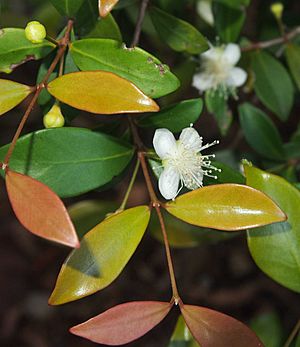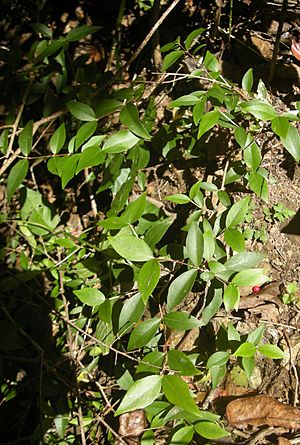Python tree facts for kids
Quick facts for kids Python tree |
|
|---|---|
 |
|
| Gossia bidwillii flower and foliage | |
| Scientific classification | |
| Genus: |
Gossia
|
| Species: |
bidwillii
|
| Synonyms | |
|
|
The Gossia bidwillii, also known as the python tree, is a type of myrtle tree. It grows in the rainforests of eastern Australia. You can usually find it in drier rainforest areas. This tree naturally grows from the Hunter River in New South Wales all the way up to Coen in far northern Queensland.
People also call this tree by other names like lignum-vitae, scrub ironwood, and smooth-barked ironwood.
Contents
What Does the Python Tree Look Like?
The python tree is a medium-sized tree. It usually grows about 18 to 25 meters (about 60 to 80 feet) tall. Its trunk can be up to 20 centimeters (about 8 inches) wide. The trunk is often a bit bent and not perfectly round.
Why is it Called the Python Tree?
The bark of this tree is very smooth. It has an orange-brown color with cool green blotchy marks. These marks make it look a lot like the skin of a python snake! That's how it got its common name, the Python Tree. The bark also peels off in thin, papery flakes.
Leaves and Branches
The small branches of the tree are smooth and brown. The leaves grow in pairs on opposite sides of the stem. They are simple, meaning they don't have any teeth or jagged edges. Each leaf is about 5 to 8 centimeters (2 to 3 inches) long. They are oval-shaped with a short leaf stem.
If you look closely at the leaves with a magnifying glass, you can see tiny oil dots. The leaves even have a faint smell, a bit like eucalyptus. You can also see the veins in the leaves clearly. There's a raised vein in the middle on both sides, and another vein runs around the edge of the leaf.
Flowers and Fruit
The python tree produces white, sweet-smelling flowers. These flowers usually appear between October and December.
Fruit and Seeds
After the flowers, the tree grows a black berry. This berry is flat and has a bumpy, warty surface. It's about 6 millimeters (a quarter of an inch) across. Inside the berry, you'll find 3 to 5 pretty mauve-colored seeds.
The fruit ripens from January to May. Many different birds enjoy eating these berries. One bird that loves them is the Rose-crowned fruit dove.
See also
 In Spanish: Árbol pitón para niños
In Spanish: Árbol pitón para niños



